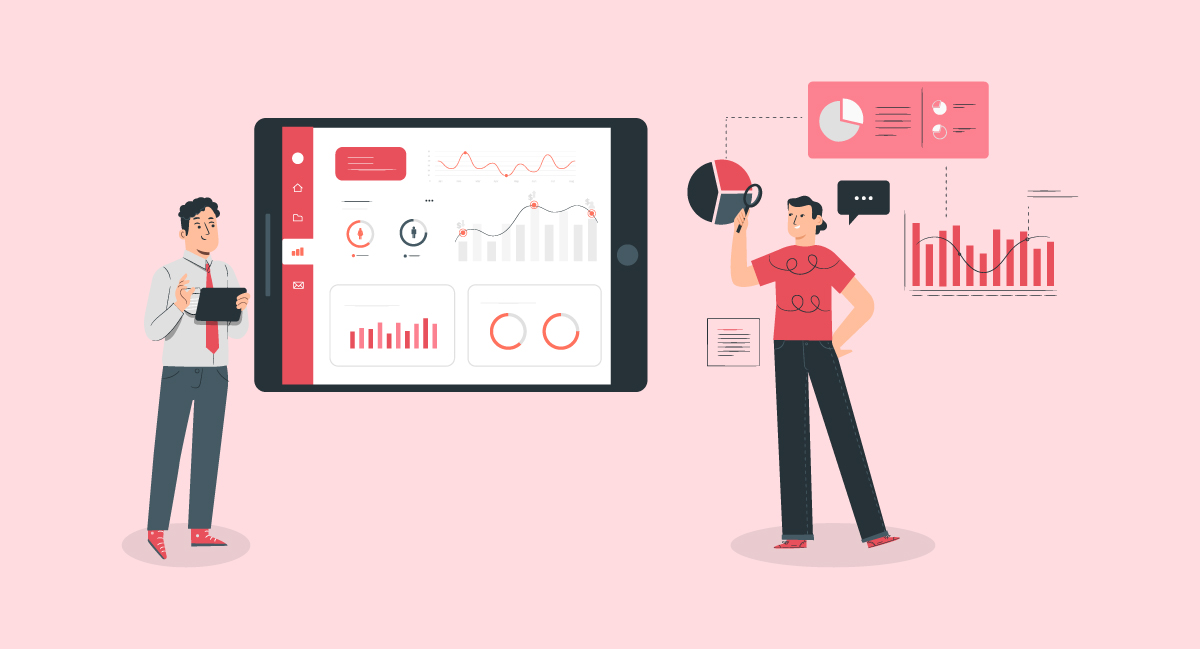Business Analytics (BA) and Business Intelligence (BI) are two related fields that have grown to be crucial for contemporary businesses aiming to obtain a competitive edge in the marketplace. Although both BI and BA employ data to acquire insights into business processes, their approaches and scope are different.
54% of businesses believe BI is critical for present and future activities. BI focuses on giving decision-makers timely, accurate data from a variety of sources to help them make better decisions and increase operational effectiveness.
On the other hand, BA analyzes historical data using cutting-edge statistical and predictive modeling approaches to find trends and patterns that can be used to forecast future business performance.
In this article, you’ll get better insight into these terms and their applications.
What Is Business Intelligence?

Business Intelligence (BI) refers to tools, techniques, and processes used to analyze, transform, and visualize raw data into meaningful insights that inform business decisions.
By delivering reliable, current, and pertinent information, BI’s major objective is to assist organizations in making wise decisions. In order to find patterns, trends, and insights that can help organizations improve their operations and plans, data must be gathered from numerous sources and analyzed, including databases, spreadsheets, and other software programs.
Data extraction and transformation into usable information are made possible for organizations by various technologies, such as data mining, data warehousing, and data visualization tools. The insights gained by BI can be applied to boost customer satisfaction, increase profitability, streamline procedures, and improve business performance.
What Is Business Analytics?

Using data, statistical and quantitative analysis, and predictive modeling methods to glean insights and arrive at well-informed business decisions is known as business analytics. To find trends, patterns, and chances for optimization and improvement in many sectors of a business, such as sales, marketing, operations, and finance, it entails the gathering, analysis, interpretation, and visualization of data.
Businesses may use business analytics to better understand their customers, provide better goods and services, streamline processes, and make data-driven decisions that give them a competitive edge. To transform raw data into usable insights, it makes use of a variety of tools and methods, including data mining, machine learning, predictive analytics, and visualization tools.
Business Intelligence Vs. Business Analytics
The terms “business intelligence” (BI) and “business analytics” are frequently used interchangeably to refer to two related but different topics. Although there is some overlap between the two, their priorities and goals are different.
The process of gathering, organizing, and analyzing massive amounts of data in order to spot patterns and trends is known as business intelligence. BI frequently offers historical perspectives on business performance, including sales trends, consumer behavior, and inventory management.
By giving decision-makers a thorough understanding of past and present business operations, BI aims to facilitate the identification of areas for development.
On the other hand, business analytics utilizes statistical and quantitative techniques to draw conclusions from data and forecast future business performance. To assist your business in making strategic decisions based on data, business analytics uses more complex modeling and forecasting approaches.
The objective of BA is to offer practical and actionable insights for the next actions to enhance business performance. Hence, you need to understand these distinct applications of both terms and act accordingly. Below we have created a quick comparison chart that you can refer to.
|
Business Intelligence |
Business Analysis |
|
|---|---|---|
| Definition | The collection, organization, and analysis of data to provide historical insights into business operations | The use of statistical and quantitative methods to extract insights from data and make predictions about future business performance |
| Focus | Descriptive analysis of past and current business performance | Predictive analysis of future business performance |
| Purpose | To provide a comprehensive view of past and current business operations and identify areas for improvement | To provide actionable insights and recommendations for future actions to improve business performance |
| Data sources | Structured data from internal sources such as databases, ERP systems, and spreadsheets | Structured and unstructured data from internal and external sources, such as social media, IoT devices, and online platforms |
| Tools | Reporting tools, dashboards, scorecards, and data visualization software | Statistical modeling and analysis tools, machine learning algorithms, data mining tools, and predictive analytics software |
| Users | Business users, executives, and managers | Data analysts, data scientists, and business analysts |
| Example | Sales reports, financial statements, inventory management, and customer behavior analysis | Market forecasting, customer segmentation, risk analysis, and fraud detection |
Now, let’s take a look at the detailed comparison between business intelligence and business analysis.
Differences Between Business Intelligence and Business Analytics
Now that you have understood the key difference between BI and BA, you can get detailed insights into these concepts and understand how they differ from each other.
1. Data Sources
The main internal sources of structured data BI uses are databases, ERP systems, and spreadsheets. On the other hand, BA employs structured and unstructured data from both internal and external sources, including social media, Internet of Things (IoT) devices, and online platforms.
2. Analysis Methods
In order to give a thorough overview of both past and present business operations, BI employs descriptive analytical techniques. This comprises data visualization software, dashboards, scorecards, and reporting tools.
As opposed to this, BA uses more complex analysis techniques, such as statistical modeling and analysis tools, machine learning algorithms, data mining tools, and predictive analytics software, to glean insights from data and forecast future company performance.
3. Scope of Analysis
In-depth analysis of recent and ongoing business performance, including sales patterns, consumer behavior, and inventory management, is the main goal of BI. On the other hand, BA offers prescriptive insights, including as market forecasting, customer segmentation, risk analysis, and fraud detection, that can assist firms in making future plans.
4. Decision-Making
Business users, executives, and managers are the main users of BI to make operational decisions based on historical and present data. It gives decision-makers a complete picture of the company, enabling them to pinpoint opportunities for improvement.
On the other hand, business analysts, data scientists, and analysts of data employ BA largely to make strategic decisions based on predictions of future business performance. Decision-makers can anticipate trends and create proactive plans for the future with the aid of BA.
Overall, BI and BA are independent but complementary domains that serve various functions in aiding organizations in making data-driven decisions. While BI offers a thorough overview of past and present business performance, BA offers predicted insights to aid firms in planning decisions.
Real-world Applications of Business Intelligence and Business Analytics
If you are wondering how both these concepts can be implemented, here we have provided a list of instances where you can apply them. Keep on reading to gain a better understanding of business analysis and business intelligence.
Business Intelligence Application

- Sales Analytics – BI may assist companies in analyzing sales data to spot patterns, track sales progress, and enhance sales tactics.
- Customer Analytics – BI may enhance customer engagement by helping firms better understand the behavior, preferences, and satisfaction levels of their customers.
- Supply Chain Management – To increase the effectiveness of the supply chain, firms can use BI to track shipments, manage inventory levels, and optimize logistics.
- Financial Analysis – BI may assist companies in tracking their financial performance, locating areas where they can cut costs, and allocating their budgets more effectively.
Business Analytics Applications

- Market Research and Forecasting – Business analysis can assist companies in analyzing market trends, consumer behavior, and the competitive environment to foresee potential trends and opportunities.
- Predictive Maintenance – BA may assist companies in tracking the performance of their equipment, spotting possible issues, and adjusting maintenance schedules to cut downtime and boost productivity.
- Fraud Detection – BA can assist companies in detecting trends and abnormalities in transaction data in order to spot possible fraud and reduce risks.
- Risk Management – BA can assist companies in identifying risks, simulating plausible outcomes, and creating risk-mitigation plans to reduce losses and enhance decision-making.
Benefits of Business Intelligence and Business Analytics
Business Intelligence (BI) and Business Analytics (BA) are critical components for modern organizations looking to optimize their operations, improve profitability, and stay ahead of the competition. Here are some of the benefits and comparison BI vs BA:
Benefits of Business Intelligence
Let’s start with business intelligence and how it has proven to be highly beneficial for every organization. Below are the main benefits of implementing business intelligence for every business.

1. Better Decision-Making
BI gives decision-makers access to precise, real-time data from various sources, including financial, marketing, and sales data, allowing them to make well-informed choices. This aids businesses in streamlining operations, enhancing customer satisfaction, and raising sales.
2. Improved Operational Efficiency
BI enables firms to examine their processes and workflows, revealing bottlenecks and inefficiencies that can be eliminated. This results in improved operational efficiency. Organizations can lower expenses and increase profits by increasing operational efficiency.
3. Enhanced Customer Experience
Personalized solutions and improved customer engagement are made possible by BI, which offers insights into customer behavior, preferences, and needs. This aids businesses in developing solid client relationships, raising client satisfaction levels, and ultimately raising sales.
4. Increased Competitiveness
By giving firms insights into market trends, client demands, and growth prospects, BI helps them stay one step ahead of the competition. Organizations can use this data to find new business possibilities and boost their overall competitiveness.
5. Data Visualization
BI presents complicated data in an understandable way using data visualization tools like charts, graphs, and dashboards. Decision-makers now have an easier time interpreting data, spotting trends, and making wise choices.
Benefits of Business Analytics
Now that you have read through the benefits of BI, here are the main advantages of implementing business analytics into business.

1. Predictive Insights
BA uses statistical analysis and predictive modeling techniques to analyze historical data and identify patterns that can be used to predict future business performance. This enables organizations to anticipate trends and proactively plan for the future, reducing the likelihood of unexpected events impacting business operations.
2. Improved Risk Management
BA allows organizations to assess risks, model potential scenarios, and develop risk mitigation strategies. This helps organizations reduce the likelihood and impact of potential risks, improving overall business resilience.
3. Enhanced Customer Insights
BA provides organizations with a deeper understanding of customer behavior, preferences, and needs. By leveraging this information, organizations can personalize offerings, improve customer engagement, and increase customer loyalty.
4. Increased Revenue and Cost Savings
BA helps organizations identify new revenue opportunities and cost-saving measures. This can lead to increased revenue and profitability, as well as improved operational efficiency.
5. Data Mining
BA uses data mining techniques to extract insights from large datasets that would be difficult to detect through manual analysis. This enables organizations to identify patterns and anomalies, improving decision-making and overall business performance.
Final Thoughts
Business intelligence tools and business analytics tools let companies learn important things about their customers, markets, and operations. Businesses may enhance decision-making, operational effectiveness, and customer experience by giving decision-makers access to reliable, real-time data management solutions.
By contrast, BA analyzes historical data and looks for patterns that can be used to forecast future business performance using statistical and predictive modeling approaches. Organizations may optimize their operations, lower expenses, boost income, and eventually gain a competitive edge in the market by utilizing business analysis and business intelligence strategy.
Frequently Asked Questions

Supriya is a highly skilled content writer with over 8 years of experience in the SaaS domain. She believes in curating engaging, informative, and SEO-friendly content to simplify highly technical concepts. With an expansive portfolio of long-format blogs, newsletters, whitepapers, and case studies, Supriya is dedicated to staying in touch with emerging SaaS trends to produce relevant and reliable content.
[adsanity_group align=’alignnone’ num_ads=1 num_columns=1 group_ids=’15192′]
Need Any Technology Assistance? Call Pursho @ 0731-6725516







